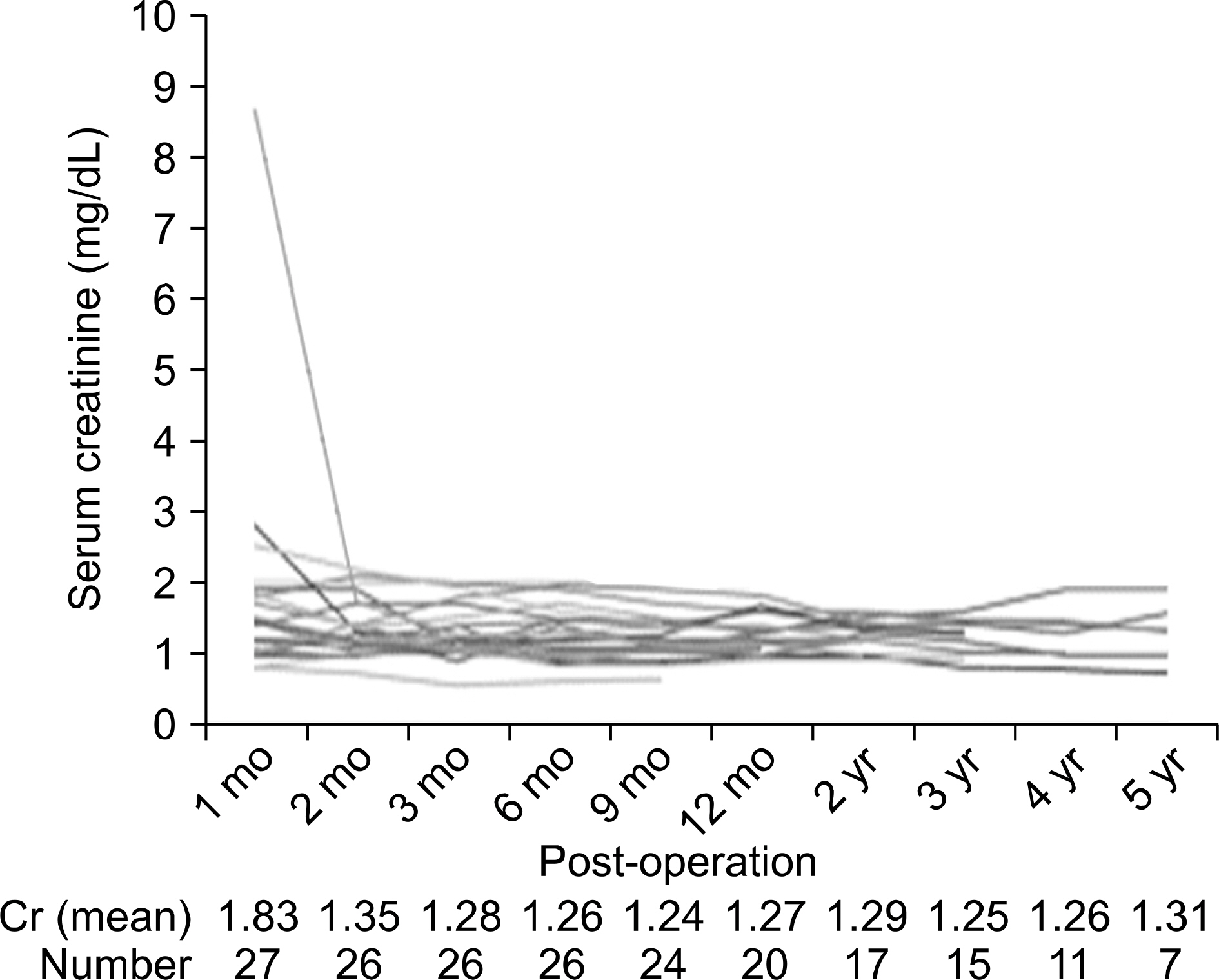J Korean Soc Transplant.
2015 Dec;29(4):233-237. 10.4285/jkstn.2015.29.4.233.
Kidney Transplantation from the Deceased Donor Who Need Continuous Renal Replace Therapy
- Affiliations
-
- 1Division of Kidney and Pancreatic Transplantation, Department of Surgery, Asan Medical Center, University of Ulsan College of Medicine, Seoul, Korea. kyh-001@hanmail.net
- 2Organ Transplant Center, Asan Medical Center, University of Ulsan College of Medicine, Seoul, Korea.
- KMID: 2202609
- DOI: http://doi.org/10.4285/jkstn.2015.29.4.233
Abstract
- BACKGROUND
Brain death donors may require continuous renal replacement therapy (CRRT) in severe acute renal failure (ARF) during management. To maximize donor organ usage we performed renal transplantation from deceased donors requiring CTTR with informed consent. This single-center study reviewed the clinical outcomes of kidney transplant recipients from extreme marginal donors requiring CRRT.
METHODS
Medical records of all patients using a graft from extreme marginal donors who underwent CRRT in Asan Medical Center between June 2007 and September 2014 were reviewed retrospectively.
RESULTS
Between June 2007 and September 2014, 27 kidneys were transplanted from 19 CRRT donors. Mean donor age was 35.1 years (range; 16~56), male donors were 14 (74%). The causes of brain death included head trauma in 6, hypoxia in 5, stroke in 4, and others in 4. The main causes of CRRT were anuria in 14, electrolyte imbalance or acidosis in 5, and mean duration of donor CRRT was 3.6 days (range; 1~11). Delayed graft function (DGF) developed in 24 (88.9%), but all recovered renal function; they can be free from dialysis 11 days after transplantation. Mean serum creatinine level at 1 month, 1 year, and 5 years was 1.85, 1.26, and 1.31 mg/dL, respectively.
CONCLUSIONS
Five-year follow-up data showed that renal transplantation from severe ARF donor has an excellent outcome. Although CRRT donor kidney transplants have a higher rate of DGF, the presence of DGF, unlike other donation after brain death donor kidney transplants, does not portend a worse prognosis.
Keyword
MeSH Terms
-
Acidosis
Acute Kidney Injury
Anoxia
Anuria
Brain Death
Chungcheongnam-do
Craniocerebral Trauma
Creatinine
Delayed Graft Function
Dialysis
Follow-Up Studies
Humans
Informed Consent
Kidney Transplantation*
Kidney*
Male
Medical Records
Prognosis
Renal Replacement Therapy
Retrospective Studies
Stroke
Tissue Donors*
Transplantation
Transplants
Creatinine
Figure
Reference
-
References
1). Korean Network for Organ Sharing (KONOS). 2013 KONOS Annual Report [Internet]. Seoul: KONOS;2014. [cited 2015 Apr 5]. Available from:. http://www.konos.go.kr.2). Lewers DT, Mathew TH, Maher JF, Schreiner GE. Long-term follow-up of renal function and histology after acute tubular necrosis. Ann Intern Med. 1970; 73:523–9.
Article3). Anil Kumar MS, Khan SM, Jaglan S, Heifets M, Moritz MJ, Saeed MI, et al. Successful transplantation of kidneys from deceased donors with acute renal failure: three-year results. Transplantation. 2006; 82:1640–5.
Article4). Morgan C, Martin A, Shapiro R, Randhawa PS, Kayler LK. Outcomes after transplantation of deceased-donor kidneys with rising serum creatinine. Am J Transplant. 2007; 7:1288–92.
Article5). Ugarte R, Kraus E, Montgomery RA, Burdick JF, Ratner L, Haas M, et al. Excellent outcomes after transplantation of deceased donor kidneys with high terminal creatinine and mild pathologic lesions. Transplantation. 2005; 80:794–800.
Article6). Jung CW, Park KT, Kim SY, Kim SJ, Kim MG, Jo SK, et al. Clinical outcomes in kidney transplantation patients from deceased donors with acute kidney injury. Transplant Proc. 2013; 45:2941–5.
Article7). Grams ME, Womer KL, Ugarte RM, Desai NM, Montgomery RA, Segev DL. Listing for expanded criteria donor kidneys in older adults and those with predicted benefit. Am J Transplant. 2010; 10:802–9.
Article8). Jafar TH. Organ trafficking: global solutions for a global problem. Am J Kidney Dis. 2009; 54:1145–57.
Article9). Kayler LK, Garzon P, Magliocca J, Fujita S, Kim RD, Hemming AW, et al. Outcomes and utilization of kidneys from deceased donors with acute kidney injury. Am J Transplant. 2009; 9:367–73.
Article10). Farney AC, Rogers J, Orlando G, al-Geizawi S, Buckley M, Farooq U, et al. Evolving experience using kidneys from deceased donors with terminal acute kidney injury. J Am Coll Surg. 2013; 216:645–55.
Article11). Ju MK, Kim BS, Jeong HJ, Kim MS, Kim SI, Kim YS. Successful kidney transplantation using deceased donor kidney with acute tubular necrosis. J Korean Surg Soc. 2008; 75(Suppl 2):430–433.12). Kim SH, Ha YE, Youn JC, Park JS, Sung H, Kim MN, et al. Fatal scedosporiosis in multiple solid organ allografts transmitted from a nearly-drowned donor. Am J Transplant. 2015; 15:833–40.
Article
- Full Text Links
- Actions
-
Cited
- CITED
-
- Close
- Share
- Similar articles
-
- Thrombotic microangiopathy, rare cause of deceased donor acute kidney injury: is a donor biopsy necessary before donation?
- Current Status of Deceased Donor Organ Recovery and Sharing in Korea
- Renal cell carcinoma in pretransplant native nephrectomy of hemodialysis patient with acquired cystic kidney disease for deceased donor renal transplantation
- Evaluation and Utilization of Expanded Criteria Dornor
- Study for the Relationship between the Post-Transplant Renal Function and the Donor Score Using Deceased Donor Scoring System



